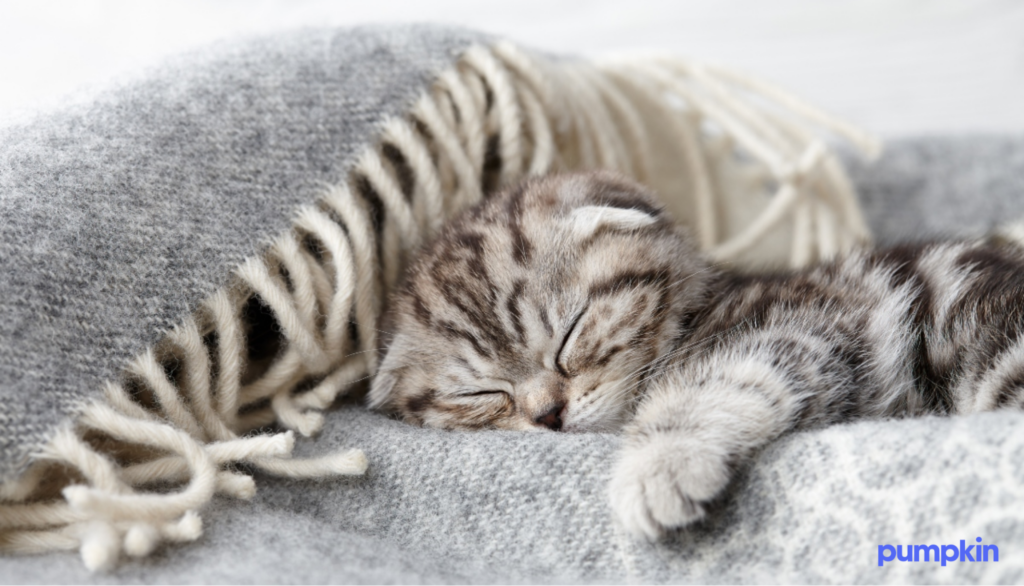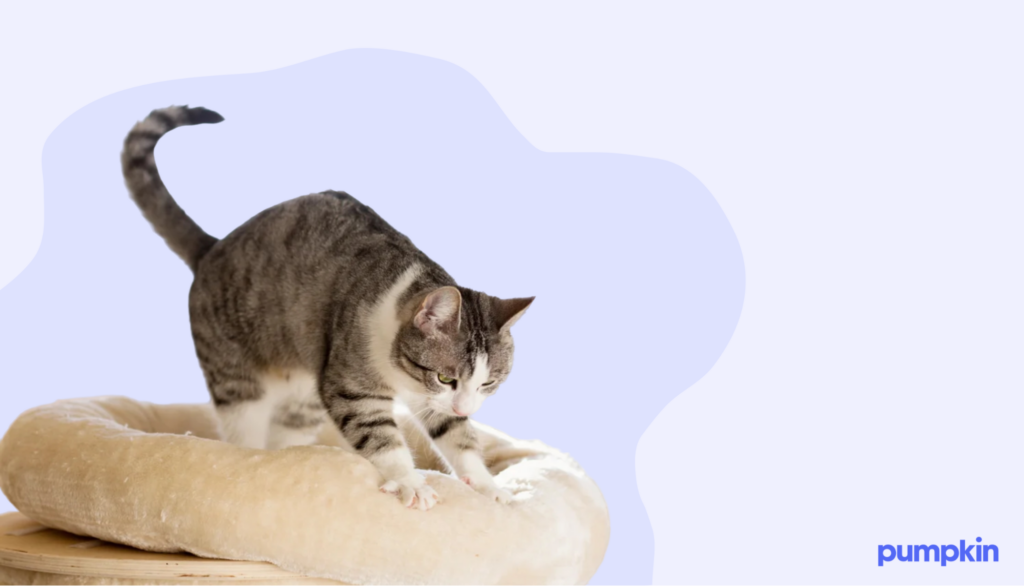Key Points
- Kneading is a natural and common feline behavior, and most domestic cats do it.
- There is no definitive reason why cats knead, but theories range from kitten instincts to comfort and scent marking.
- Cat kneading isn’t a behavioral problem unless it’s accompanied by aggressive behavior.
Cats can be mysterious creatures, and some of their behaviors are a little peculiar. From sitting in boxes to bringing you rodent “gifts” to intentionally knocking over your favorite mug — life with a cat is never dull.
As mischievous as they can be, our kitties can be equally adorable. One second they’re causing trouble, and the next they’re curling up in our lap and kneading. Most cat owners are very familiar with that back-and-forth movement of those little paws, also known as “making biscuits.”
Cat kneading usually isn’t a problem — unless you’re really attached to your sweaters and knitwear. Of course, fashion mavens are used to sacrificing their finest outfits to cat hair and claws.
While cat kneading is instinctive (and completely normal), in some cases, it can be a sign of anxiety or stress. Have you always wondered: Why do cats knead? Then keep reading to discover the most common reasons.
What is cat kneading?
Cat kneading is a behavior that mimics the way a baker moves bread dough, which is why we lovingly call this cat behavior “making bread” or “making biscuits.” Your cat uses their paws in a steady, rhythmical motion to push and pull against a comfy surface like a soft blanket, pillow, or your belly.
Most, but not all, domestic cats knead, and the process can look different from cat to cat.
Some cats may purr loudly or quietly, while others may drool as they continue with the motion.
You might find a cat that uses their back paws in addition to their front paws, or some that knead with extended claws. Certain cats will also suckle on the corner of a pillow or blanket.
Top reasons why cats knead
Kneading is a common behavior, but why do cats do it? Here are some of the most popular theories:
1. Kitten instincts and neoteny
Some animal behaviorists believe that kneading is an instinctual behavior that cats bring from kittenhood into adulthood.
When kittens are born, they get nourishment from their mother’s milk. During this time, kittens knead or push against their mother’s mammary glands to stimulate the flow of milk so that they can nurse.
As adults, cats still associate the movement of kneading with the comfort of nursing. They continue to knead soft surfaces and objects even though they don’t stimulate milk production.
You might even see adult cats that exhibit suckling behaviors or give love bites while kneading. Compared to their wild cousins, our pets are much more likely to retain juvenile behavior into adulthood, a phenomenon called neoteny.
2. Preparing a place to sleep
Kneading may be a call back to your cat’s ancestors. Wild cats, such as cheetahs, lions, and jaguars, use the kneading motion to shred or flatten tall grass and vegetation. This activity softens the ground and gives them the perfect place to sleep or give birth. This process also means that they can check the grass and surrounding areas for predators.
Some people think that domestic cats have carried this behavior with them and now use it to prepare a comfy resting spot.

3. Marking territory
Cats have scent glands between the soft pads of their paws that release pheromones. So, when they knead a soft surface, it releases the scent into whatever they’re kneading. In doing this, your cat is marking their territory or claiming an object (or human) as their own. They dig their claws into your furniture for the same reason.
When a cat kneads and purrs in your lap — they’re showing you that they’re relaxed and comfortable. And their scent tells other animals that you belong to them. It’s just one way that cats say they love you.
4. Looking for a mate
When female cats go into heat (also known as oestrus), they may display kneading behavior to show male cats they’re ready to mate. Spaying may decrease some of these behaviors if they’re directly related to a female cat’s estrus cycle.
5. Stretching out
Cats will knead to stretch out their legs, shoulders, and toes. You’ll often see cats kneading a familiar surface as they wake up from a nap to get ready for a day of adventures.
Cats can also knead when they need a good stretch to limber up their muscles. Or, if they have a sore spot, this curious cat behavior can relieve aches and pains.
If you notice your cat limping, bleeding, or in visible pain, call your local veterinarian as soon as possible.
6. Showing comfort and affection
Kneading is one of the ways cats show affection. When your cat kneads, you may notice other loved-up behaviors such as eye-blinking, purring, and face smooching. Your cat may also snuggle deep into a blanket or soft space.
Many cats knead when they’re happy — whether they’re getting ready for a nap or cuddling with you on the couch.

You might notice that your cat likes to knead while being petted, or kneads on your lap before settling down to sleep. Similarly, if your cat feels you’re not giving them enough attention, they may jump up and start to knead just to make sure all your focus is on them.
If you are your pet’s favorite kneading spot, then you know sharp nails in your skin can hurt. Consider putting a folded towel on your lap to give them something to knead their claws into.
And if your cat doesn’t knead, there’s no need to panic — it’s just not their “thing.” They will find other ways to self-soothe and show their affection.
7. Getting ready for labor
If your cat is pregnant, kneading can be a sign of nesting. When your cat is nesting, they will try to find a quiet place to hide away and rest. Kneading in this place is your mama cat’s way of creating a safe and cozy space for her new litter.
8. Calming anxiety
Kneading can be a calming behavior and is a way for cats to settle their nerves. Cats can feel anxious or stressed for a range of reasons, such as:
- When they are adjusting to new surroundings
- The introduction of a new pet
- If they experience trauma or fear
- If they are suffering from an illness or injury
Your cat can also feel stressed if they’re left home alone for too long. Try not to leave kittens by themselves for longer than 4 hours. For adult cats, you should have someone check on them after 24 hours.
Okay, but why does my cat knead so much?
All cats can knead their paws, including wild cats. However, some do it more than others, and this can be due to a range of factors:
Personality type: Kneading helps cats relax, and some kitties may need comfort and stress relief more than others.
Unspayed females: Before unspayed cats go into heat, they may knead more often. This tells males they are ready to mate.
Breed: Affectionate breeds tend to enjoy more frequent kneading, such as Siamese, Tonkinese, and Balinese cats.
Age: Kittens start kneading at 1 to 2 weeks old. Some cats reduce their kneading frequency as they grow older, but it’s a lifelong behavior in many domestic cats.
Is cat kneading ever a problem?
Kneading is a completely natural behavior and isn’t usually flagged as a behavioral issue.
However, kneading can be problematic if:
- It harms you or another animal
- Male cats start salivating and become aggressive while kneading
- Kneading becomes obsessive or compulsive
- Your cat appears to be uncomfortable or in pain
If you think your kitty’s kneading is becoming a problem, check in with your vet.
Tips to promote safe kneading behavior
Most cats use kneading for relaxation and to show contentment. If your cat uses their claws too much, it can leave snags in your clothing, favorite pillow, or comforter. It can also hurt!
If kneading is becoming a problem, follow these steps to discourage a kneading session.
Never discipline your cat for instinctual behavior. Cats are born needing to knead (you could say they have a need for knead), and the urge may never go away. Using harsh discipline methods will only damage your relationship.
Clip your cat’s nails. When your cat’s claws are not razor sharp, kneading won’t cause as much damage. This behavior is much more tolerable if you regularly trim your cat’s claws.
Use a soft barrier. A soft object like a thick blanket, folded towel, or pillow, will protect your clothes and skin from punctures or damage.
Discourage the motion. Gently put pressure on your cat’s paws to slow down the motion or stop it. You can also gently put pressure on your cat’s back to encourage them to lie down.
Distract them. Try offering treats, toys, or even catnip to distract your feline friend.
The bottom line on cat kneading
As long as your cat’s kneading sessions aren’t harming anyone, you can rest assured this is perfectly safe and normal feline behavior.
It’s an instinct cats can carry throughout their lives, and kneading can be proof your cat is content and confident. Some cats use kneading to mark their territory and to claim you as their own, while for others it’s a self-soothing technique.
It’s important to check in with your vet if you notice any behavioral changes. Having a cat insurance plan in place can help cover the cost of eligible vet bills for unexpected health problems that come up in the future.
FAQs
- https://www.alleycat.org/community-cat-care/kitten-age
- https://warrickvet.com/blog/what-is-cat-kneading-and-why-do-they-do-it/
- https://eastsidevet.com/2022/03/25/why-your-cat-needs-to-knead/
- https://www.catcarecenter.com/services/cats/blog/felines-pheromones-and-claws
- https://vcahospitals.com/know-your-pet/first-aid-for-limping-cats
- https://bettervet.com/resources/pet-lifestyle/cat-nesting-behavior




